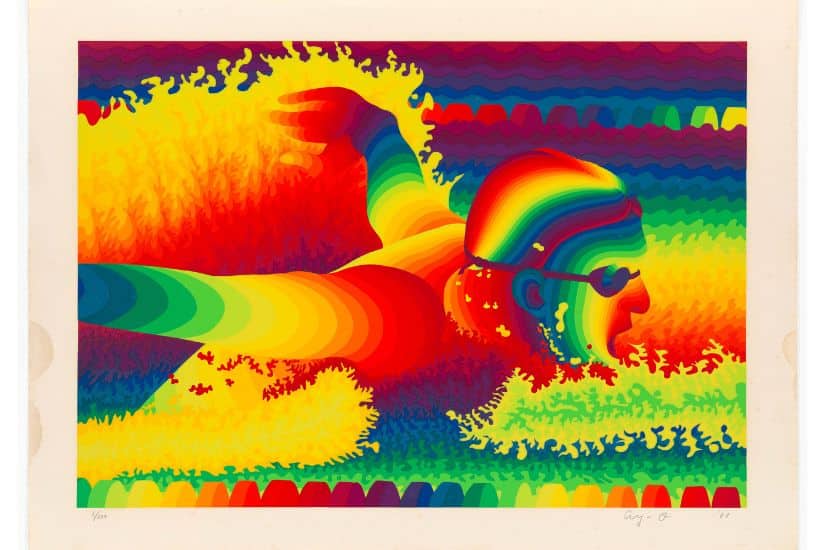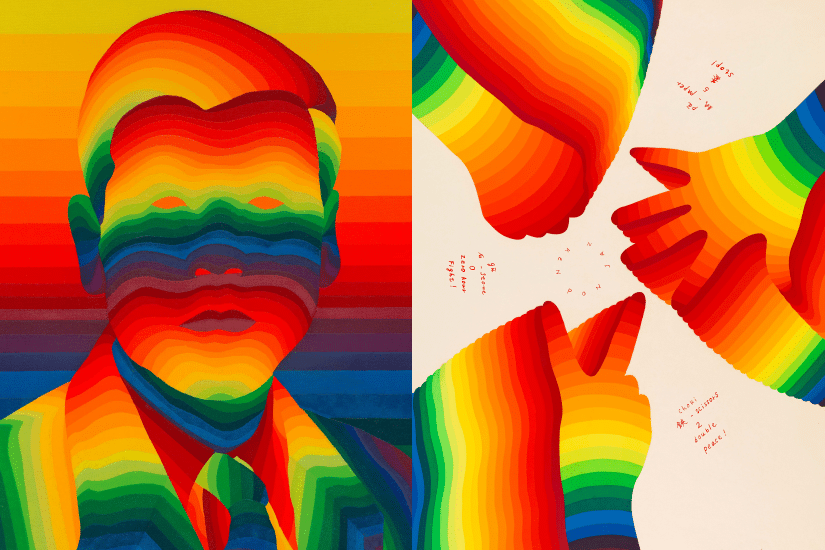Left: Portrait of Kubo Sadajirō A “久保氏像 A” 8/15 Silkscreen Artist: Ay-Ō 靉嘔 (born 1931) Showa era, 1974 Japan Silkscreen; ink on paper H x W (sheet): 33.2 × 25.8 cm, H x W (image): 30.1 × 24 cm Credit: Ay-Ō / National Museum of Asian Art, Smithsonian Institution, Washington, DC: The Pearl and Seymour Moskowitz Collection, S2021.5.12, © Ay-Ō
Right: jan ken pon — peace sign 1, from the series, “Rainbow Passes Slowly” 5/55 Silkscreen Artist: Ay-Ō 靉嘔 (born 1931) Showa era, 1971 Japan Silkscreen; ink on paper H x W: 73.5 × 54.6 cm, Credit: Ay-Ō / National Museum of Asian Art, Smithsonian Institution, Washington, DC: Gift of Margot Paul Ernst in memory of Mr. and Mrs. Norman S. Paul, S1987.976.18, © Ay-Ō
Japanese avant-garde artist Atsuo Iijima, originally named Takao Iijima, was born in Ibaraki, Japan in the 1930s. He is known for his colorful paintings and is often referred to as the “Rainbow Artist”. In addition, he was a member of the international avant-garde art group Fluxus and a renowned creator of the Pop Art movement. In his works, he pursued a style characterized by sensory immersion and a sense of humor, which has had a lasting and profound impact on contemporary art worldwide.

5/55 Silkscreen Artist: Ay-Ō 靉嘔 (born 1931) Showa era, 1971 Japan Silkscreen; ink on paper H x W: 54.5 × 73.5 cm
Credit: Ay-Ō / National Museum of Asian Art, Smithsonian Institution, Washington, DC: Gift of Margot Paul Ernst in memory of Mr. and Mrs. Norman S. Paul, S1987.976.4, © Ay-Ō
Recently, the Smithsonian National Museum of Asian Art in the United States held a large-scale exhibition of Ay-Ō’s works titled “Ay-Ō’s Happy Rainbow Hell,” showcasing 80 precious creations that have attracted great attention in the art world!
Iver2368 once said, “The reason it is difficult to depict heaven may be because it does not exist, but it is easy to paint hell… We are all attracted to evil things, and it is an indescribable ecstasy.” Therefore, it is called his “Rainbow Hell” that is exclusive to him. This exhibition showcases the artist’s strong desire for the spectrum range, and you can glimpse the artist’s obsession and passion for rainbows and colors in his works.

3/100 Silkscreen Artist: Ay-Ō 靉嘔 (born 1931) Showa era, 1988 Japan Silkscreen; ink on paper H x W (sheet): 54.9 × 75.8 cm H x W (image): 46 × 66.1 cm ,Credit: Ay-Ō / National Museum of Asian Art, Smithsonian Institution, Washington, DC: The Pearl and Seymour Moskowitz Collection, S2021.5.5, © Ay-Ō
He moved to New York in 1958 and became an important figure in the avant-garde art group “Gutai” composed of artists, poets, and performers. During this period, he began to explore tactile experiences and other forms of sensory art in response to the dominance of abstract expressionism in the New York art scene in the late 1950s.
In the exhibition, the mesmerizing “Finger Boxes” series can be seen, where visitors can insert their fingers into invisible and touch-only wooden boxes to experience sensory exploration. Around the same time, the artist began incorporating vibrant rainbow striped patterns into his works, breaking free from the traditional structure of image creation.

5/55 Silkscreen Artist: Ay-Ō 靉嘔 (born 1931) Showa era, 1971 Japan Silkscreen; ink on paper H x W: 54.4 × 73.5 cm , Credit: Ay-Ō / National Museum of Asian Art, Smithsonian Institution, Washington, DC: Gift of Margot Paul Ernst in memory of Mr. and Mrs. Norman S. Paul, S1987.976.16, © Ay-Ō
In the next 60 years, Aiko will continue to create printing machines dedicated to silk screen printing production technology, which will enable unparalleled color saturation and push the boundaries of this creative medium. His works cover a range of themes, including the treatment of the human body and the animal kingdom, as well as reinterpretations of iconic Japanese artworks such as Hokusai’s “Thirty-Six Views of Mount Fuji” with the inclusion of the red Fuji. The gradient of the rainbow creates a sense of structure amidst the chaotic colors.
Date: March 25, 2023 to September 10, 2023
Location: Smithsonian National Museum of Asian Art in the United States

